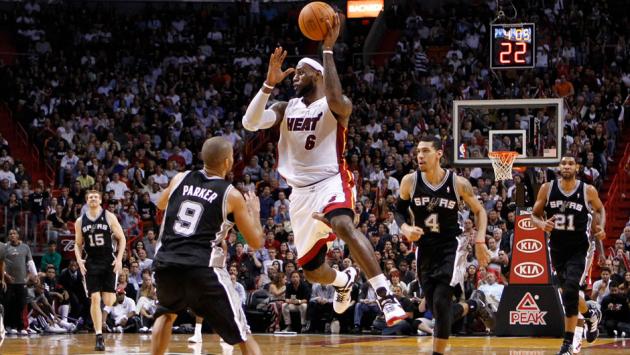 |
| Would a 2-2-1-1-1 format have changed last year's Finals? |
So what does it mean?
Well, it should matter competitively. In the playoff, 14 of the 15 series used the 2-2-1-1-1 format with only the Finals using the 2-3-2 (for the uninitiated, the 2-3-2 means the team with the better record plays the first two games of the series at home, the next three on the road and the final two at home. A 2-2-1-1-1 format means the team with the better record plays Games 1, 2, 5 and 7 at home). The 2-3-2 mainly came about in the 1980s when the Lakers and Celtics or Sixers met up in the Finals nearly every season and players, coaches, media and the like had to keep flying cross country four times to do the Finals.
This is 2013 and teams fly on private planes. Reporters have laptops, internet and smart phones to do their jobs covering the Finals. Media outlets have access to each Finals city (ESPN won't have a problem moving their coverage back and forth). We can have a Clippers-Grizzlies playoff series with hardly any issues with travel for a 2-2-1-1-1 format so what's a little more flying? The need for having just two "site changes" isn't really there anymore. The logistics have changed.
So let's look where it would really matter: on the court.
True, there would be more travel for the players. I don't see this as that big of a deal anymore. Again, each team would've played a 2-2-1-1-1 series three times before getting to the Finals. And again, the travel plan isn't the same as it was 30 years ago. Comfy flights with a lot of ways to coach in the air.
What will change is the feeling of the Finals. The underdog entering the Finals had that feeling that if they stole Game 1 or 2 in the favorite's building, they'd have three straight games at home to wrap it up. That doesn't seem fair to the team with the home court advantage. At the same time, that underdog better win all three games at home (effectively beating a better team three times in a row in the same building ... even if it is yours) or they risk going back to the big dog's place and having to win both games.
The NBA did have a bit of storyline due to this as there were times where the underdog held a 3-2 Finals series lead heading into those final two games. It appears that the underdog is pulling off an upset when in reality, the team with the home court advantage hasn't even lost that advantage yet. Heck, it happened last year. The Spurs held a 3-2 Finals lead over the Heat after the three game stretch in San Antonio. Miami went back to South Beach and pulled off wins in the final two games and won the series. Partly because of that, we regarded it as a thrilling series. It worked!
But not often. That has only happened four times in the 2-3-2 era (1988 Lakers, 1994 Rockets, 2010 Lakers and 2013 Heat). Aside from those instances, only the 2005 Finals (Spurs-Pistons) went to a Game 7 during the 2-3-2 format.
In the 30 years prior to that change, we saw TEN Game 7s ... obviously twice as many as the 30 years since. Note that the 1971 series between Milwaukee and Baltimore had a 1-1-1-1-1-1-1 format, the 1975 (Warriors-Bullets) and 1978 (Sonics-Bullets) Finals in a 1-2-2-1-1 format -- with the '78 series going to a Game 7. So the thrill isn't really there in the 2-3-2 format.
I didn't really care either way. I'm 38 years old so it has basically been the way it is my entire life. However, I do see the need to change it back to the old way. Here's hoping we see a lot more great Finals.

No comments:
Post a Comment